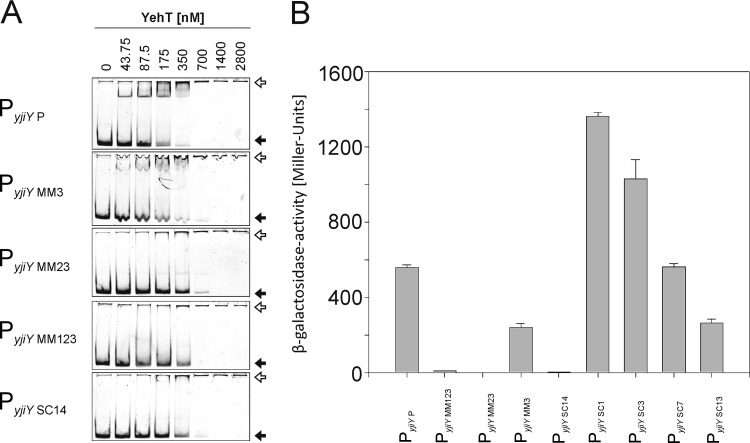Fig 4.
Effects of substitution mutations in the yjiY promoter on in vitro YehT binding and YehT-dependent promoter activity in vivo. (A) The wild-type core region PyjiY P (bp −101 to −44) (Fig. 3C) of the yjiY promoter, comprising motifs M1, M2, and M3, and several mutated variants of the same region were analyzed by EMSA following incubation with the indicated concentrations of 6His-YehT. In the mutant fragments, motifs M1 to M3 were systematically removed by substituting purines in the sequence for pyrimidines and vice versa. The resulting fragments were designated PyjiY MM3 (M3 site replaced), PyjiY MM23 (M2 and M3 replaced), and PyjiY MM123 (all three M sites replaced). In addition, the 14-bp spacer between M1 and M2 was mutated in the same way, resulting in fragment PyjiY SC14. All fragments were analyzed by EMSAs. The positions of free DNA (filled arrows) and YehT-DNA complexes (open arrows) are marked. (B) Effects of the various substitutions within the yjiY promoter on YehT-dependent transcription in vivo. E. coli MG1655-ΔlacZ/pBAD18-yehT was transformed with plasmid pRS415 encoding various yjiY promoter∷lacZ fusions (see the text for detailed descriptions). Bacteria were cultivated under aerobic growth conditions in LB medium at 37°C until the exponential-growth phase. Then yehT overexpression was induced by adding 0.2% (wt/vol) l-arabinose, and cells were harvested after 45 min. β-Galactosidase (LacZ) activity was then determined as a measure of yjiY promoter activity. Experiments were performed at least three times, and error bars indicate the standard deviations of the means.

